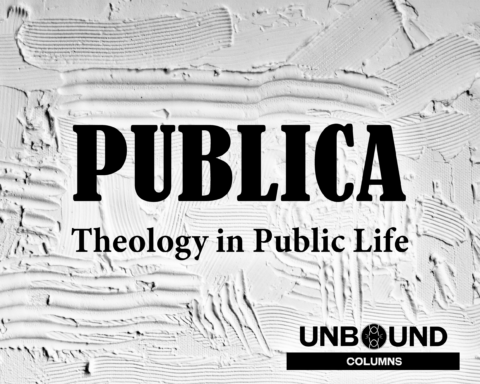While they were talking about this, Jesus himself stood among them and said to them, “Peace be with you.” They were startled and terrified, and thought that they were seeing a ghost. He said to them, “Why are you frightened, and why do doubts arise in your hearts? Look at my hands and my feet; see that it is I myself. Touch me and see; for a ghost does not have flesh and bones as you see that I have.”
And when he had said this, he showed them his hands and his feet. While in their joy they were disbelieving and still wondering, he said to them, “Have you anything here to eat?” They gave him a piece of broiled fish, and he took it and ate in their presence. Then he said to them, “These are my words that I spoke to you while I was still with you–that everything written about me in the law of Moses, the prophets, and the psalms must be fulfilled.”
Then he opened their minds to understand the scriptures, and he said to them, “Thus it is written, that the Messiah is to suffer and to rise from the dead on the third day, and that repentance and forgiveness of sins is to be proclaimed in his name to all nations, beginning from Jerusalem. You are witnesses of these things.“
– Luke 24: 36-48
Brooke Scott, a young, Black leader in the Presbyterian Church USA, in an Instagram Story question, asked, “What does it mean to you that Jesus still had scars after the resurrection?” Flipping through my Instagram stories, I held my finger on this question, and stared at it for about 15mins. What did it mean to me that Jesus had scars on his side, his hands, his feet? What did it mean that the resurrection was a bodily resurrection, keeping all the imperfections and trauma?
I sat perplexed looking at a scar on my hand made from years and years of picking at it because of anxiety and stress. I went to a mirror and looked at the scar under my eye from where I fell out of a van when I was around 5 or 6. I lowered the waist of my shorts to see a scar made from a hernia surgery when I was 3. I opened my mouth and saw the years of scars made from anxiety driven mouth biting and self-harm. I looked my body over, pointing out each and every flaw. And I still sat wondering what it meant.
And then I read the lectionary text for this Sunday – a story of the resurrected Jesus, showing off his scars and being hungry. This story displays the resurrection not as just some mystical, spiritual, ghostly, or metaphysical event. But it was fleshy. It was real. It was touchable and biological. Rising from death, was the actual body of Jesus – and that scared the hell out of people. And why wouldn’t it, though this is the second time it happened. Remember our brother Lazarus? Lazarus was dead for days and smelly and decaying and yet, walked out of a tomb, body and all. Resurrection is physical. Resurrection is incarnational. And resurrection is hard work. Jesus, surrounded by the fear of his on-lookers, asked for food. He asked for sustenance for the body that had been through hell, death, and new life. And he ate fish – a symbol throughout the biblical text.
Brooke’s question, the text from Luke, scars, resurrection, and fish fumbled and bounced around in my mind. And then, another murder, another Black sibling killed, Duante Wright murdered by a white police officer. More mass shootings. More death dealing, white supremacist, and idolatrous wounds inflicted. More divine bodies marred and taken. All of this mixes into a theological conundrum: why are some able to live to see their scars? Why are some and not others able to live to eat their next meal? What does bodily resurrection mean when the gun shots and wounds send our Black siblings into tombs and we never see them again?
Duante Wright, executed by the state just as Christ was, won’t walk into a room, scars and wounds on display, and ask for a meal. He shouldn’t have been murdered. His life shouldn’t have been taken, just as Christ’s life shouldn’t have had to be taken. Lenny Duncan’s words during Next Church Conference, “I don’t believe Christ had to die on the cross…the blood was not necessary.” Empire, and white supremacy, forces of evil, took these lives…
So, resurrection, right now in this season of Easter, seems far-fetched. And yet, as I look at my scars, I see my white skin. I see whiteness and much of white Christianity sees that same whiteness upon Christ. And I wonder if the wrong Christ was resurrected, did we, the white church, resurrect a Christ that doesn’t exist and the real, Brown Christ is elsewhere? Yes, the Christ we raised is a Christ that does not exist. That white, muscled, hypermasculine Jesus did not actually walk out of the tomb – we, white people, made that up. That Jesus can display his scars because that Jesus wasn’t gunned down for no reason other than racism.
So what does the actual resurrection mean? The resurrection of a Brown man tagged as an enemy of the state? The actual Brown body with scars walking around and eating and talking?
I don’t know if the white church even knows what that means. Because if it did, we’d be doing everything in our power to stop more executions, murders, and death of our Black, Brown, AAPI, disabled, and queer siblings. If we followed the real resurrected Jesus, we wouldn’t want what happened to him to happen to anyone ever again. No scars. No need to ask for food. We’d want to put that white Jesus back into the tomb to stay, double seal the entrance, with a multitude of guards on standby. Because resurrection is about our embodiment of the divine displaying our humanity and all its wonderfulness.
I can still look at my scars; though they are the results of homophobia, body shame, body dysmorphia all connected to the fake, white Christ. But I can still do that and others cannot. That same Christ has created a culture where I can sit and examine my scars and what that means while others will never be able to see themselves in a mirror again.
Scrolling through your Instagram feed, what would you respond when asked, “What does the scars on the resurrected Jesus mean to you?”

Brooke Scott is certified and ready to receive a call in the Presbyterian Church (USA). She holds both a Masters of Divinity degree and a Masters of Social Work degree from North Carolina. She is passionate about liturgy and preaching that is dedicated to uplifting historically marginalized groups. Her approach is rooted in the Reformed tradition, as well as feminist/womanist, Black, and Queer theologies. Brooke has worked in both the city and the suburbs, and views her calling as a bridge between the local church and the wider community. She has experience working with diverse populations and topics, including mental health care, racial justice, poverty intervention, and housing insecurity. She currently lives in the Philadelphia area, where she was born and raised.

Lee Catoe is the managing editor of Unbound and the Associate for Young Adult Social Witness for the Presbyterian Church (USA).






Unbound Social